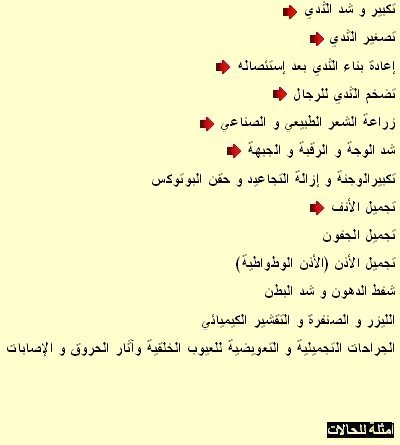Breast augmentation
Breast augmentation is done using a
prosthetic implant that does not react with the body tissues. It is implanted
through a very small incision in the infra-mammary crease which will not
be apparent as it is in the under surface of the newly sized breast.
The procedure has not been found
to cause any harmful side effects, nor to cause cancer. There are two types
of implants: the saline filled implants and the silicone gel implants.
Both types can be implanted under the breast or under the chest muscles
below the breast. The latter way is used more as the implant can not interfere
in the future with breast examination, mammograms or any breast procedure.
The main concern in breast augmentation
is the development of breast capsule (fibrous tissue reaction around the
implant) which may cause alteration of the shape of the breast if what
is known as capsular contraction occurs.
Ways to avoid breast capsular contraction:
Many methods to prevent capsular
contractions are used
1- Selection of implant type: Saline
filled implant have very little incidence of capsular contraction compared
with Silicone gel implants
2- Selection of implant surface:
Textured implants have very little incidence of capsular contraction compared
with smooth ones
3- Place of implantation: Submuscular
implantation have very little incidence of capsular contraction compared
with subglandular ones
4- Postoperative breast excercises:
During postoperative period, the patient is instructed to do certain breast
excercises in all directions which markedly reduces the possibility of
developing capsular contraction
The procedure is done under general
anesthesia as a day case surgery, the patient can leave hospital at the
same day.
Postoperatively there is no significant
pain, just slight discomfort from the muscle being stretched over the implant,
which will fade over the following weeks, meanwhile the patient is instructed
not to lift heavy objects.
The patient will wear restrictive
garments or hard bras for the first week after surgery in order to keep
the desired position of the implant and to help moulding the shape of the
augmented breast.
It is a safe and simple surgery with
almost no side effects and a great aesthetic benefit.
Breast lifting (Mastopexy)
Different procedures are done to treat
breast sagging (ptosis) which usually occur after multiple pregnancies
and lactation, or may occur in young individuals before marriage.
According to the degree of breast
ptosis, different modalities of treatment are used:
1-In mild
ptosis: use of breast implant alone can achieve the desired lifting with
minimal enlargement of the breast through a very small incision on the
under surface of the breasts.
2- In moderateptosis:
the desired lifting is usually done through incisions around the areola
and a longitudinal incision below the areola . Both incisions usually heal
very well with the least conspicuous scars
3- In severe
ptosis: A formal lifting procedure should be employed entailing a circumareolar
incision, a longitudinal incision as well as a transverse incision under
the breast (The formal T-incision)
In all conditions the patient can
leave hospital the same day. The use of drains may be needed which are
usually removed after 48 hours. The patient will wear non-soft bras immediately
after surgery. |




























